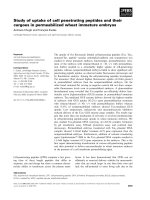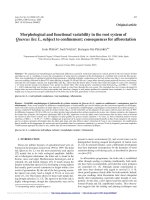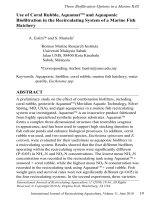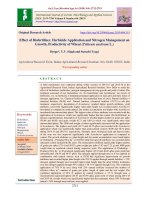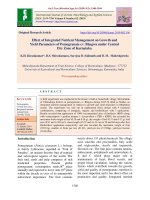Effect of crop establishment and nutrient management on growth parameter and nutrient uptake in maize wheat system of northern plains of IGP
Bạn đang xem bản rút gọn của tài liệu. Xem và tải ngay bản đầy đủ của tài liệu tại đây (318.42 KB, 13 trang )
Int.J.Curr.Microbiol.App.Sci (2019) 8(3): 305-317
International Journal of Current Microbiology and Applied Sciences
ISSN: 2319-7706 Volume 8 Number 03 (2019)
Journal homepage:
Original Research Article
/>
Effect of Crop Establishment and Nutrient Management on Growth
Parameter and Nutrient Uptake in Maize Wheat System of
Northern Plains of IGP
Lakhapati Singh*, U.P. Singh and M.K. Singh
Department of Agronomy, Institute of Agricultural Sciences,
Banaras Hindu University Vanarasi, India
*Corresponding author
ABSTRACT
Keywords
Crop establishment
methods,
Conservation
agriculture, Maizewheat system,
Nutrient uptake and
residue
Article Info
Accepted:
04 February 2019
Available Online:
10 March 2019
A field experiment was conducted 2013-14 and 2014-15 at Agricultural Research Farm,
Institute of Agricultural Sciences, Banaras Hindu University is situated in the South-East
direction. The geographical situation of the farm lies at 2518N latitude and 8331E
longitude at an altitude of 75.7 meters above the mean sea level in the Northern Gangetic
Alluvial plains and soil textural class is sandy clay loam soil to study the effect of crop
establishment method and nutrient management in maize wheat system. The experiment
consisted of four crop establishment method [C 1-Conventional/Farmers Practice (FP), C2Improved over (FP), C3- Partial Conservation Agriculture (CA), C4- Full Conservation
Agriculture (CA)] as main plot treatment and three nutrient management (N1 Farmer
fertilize practice (FFP), N2 Recommended dose of fertilizer (RDF), N3 Site specific nutrient
management (SSNM) as sub plot treatment laid out in split plot design with three
replication. Significant improvement in the growth character and nutrient uptake was
observed with C4 as per crop growth stage and nutrient uptake which was at par with C 3
treatment. Among nutrient management treatment (N3) resulted in higher growth
parameter nutrient uptake which was at par with recommended dose of fertilizer (N2).
Introduction
Maize (Zea mays L.) is one of the most
important crops in world’s agricultural
economy grown over an area of 159 million
hectares with a total production of 817 million
tonnes. India ranks fourth in area and sixth in
production of maize. In India, it is an
important cereal crop next only to rice and
wheat with acreage of around 8.36 m ha and
production of 16.72 million tonnes with
highest per day productivity. As it has yield
potential far higher than any other cereal, it is
commonly known as the ‘Miracle crop’ or the
‘Queen of Cereals’ (Anonymous, 2011). The
consumption pattern for maize produced in
India at present includes poultry feed (52%),
human food (24%), animal feed (11%), starch
(11%), brewery (1%) and seed (1%) (Sain
Dass et al., 2007). As per the estimated
305
Int.J.Curr.Microbiol.App.Sci (2019) 8(3): 305-317
projection, India may have to produce 55
million tonnes of maize to meet its
requirement for human consumption, poultry,
piggery, pharma industry and fodder by 2030.
Among food crops, maize and wheat are two
important cereals contributing to food and
nutritional security at the global level. Maize–
wheat (MW) cropping systems mainly
practiced in Indo- Gangetic Basin is the fifth
major crop sequence of India being practiced
on about 1.80 m ha area (Timsina et al., 2010)
and contributes 2.4 % to the national food
basket (Jat et al., 2011). The unprecedented
demands of the spiraling population are
putting a considerable strain on the natural
resources. In the past the focus was on
increasing food production to attain selfsufficiency, but indiscriminate use of
resources not only led to the reduction in total
factor productivity but also resulted in
environmental degradation (Yadav, 2003).
The focus has now shifted to sustainable
production technologies and resource efficient
cropping systems. Among the various inputs,
water and fertilizer (nutrients) are considered
as the two key inputs making maximum
contribution to crop productivity.
Sustaining soil organic carbon (SOC) is of
primary importance in terms of cycling plant
nutrients and improving the soils’ physical,
chemical and biological properties. SOC is an
important index of soil quality because of its
relationship with crop productivity (Lal,
1997). Singh et al., (2011) reported that the
different tillage and residue management
practices could potentially lead to significant
difference in soil organic carbon (SOC)
content, bulk density and irrigation water
requirement. Inclusion of partial crop residue
remarkably improved SOC content by
12.60%, bulk density by 6.27% and reduced
irrigation water by 18.88% over conventional
till (CT). Raised fresh bed being statistically at
par with CT resulted in significant increase in
mean grain yield by 20.8 and 19.6 % (kharif)
and 22.5 and 15.3 % (rabi), respectively, over
the zero tillage with residue. A number of
field studies have been conducted to determine
the effects of varying tillage practices on the
soil surface residue cover, soil water
distribution and maize production but more
efficient moisture use and improved soil
physical properties associated with zero tillage
are often cited as reasons for the success of
zero tillage systems on well drained soils
(Griffith et al., 1986). Compared to CT,
minimum till with residue (MTR) proved to be
a promising alternative soil management
practice to improve and sustain higher yields
of rainfed maize in a sub humid subtropical
climate. This practice also improved soil
quality by increasing organic carbon,
aggregation, infiltration rate and soil water
retention, as well as decreasing bulk density
near the soil surface (Ghuman and Sur, 2001).
By reducing tillage, farmers save labour and
money that would otherwise be invested in
implements and tractor power (Smart and
Bradford, 1999). In addition to the economic
benefits, CA can improve soil health by
increasing soil organic matter and biological
activity as well as macro porosity, water
infiltration and the amount of plant-available
soil water (Wright et al., 2005). In addition to
decreasing soil temperature and evaporation, a
permanent surface residue layer provides a
barrier against rapid water runoff (Findeling,
2001).
Conservation
agriculture,
i.e.
residue
retention, zero tillage and crop rotation
improves water use efficiency, decreases soil
erosion and temperature, improves soil quality
and increases yields (Lichter et al., 2008).
Soil moisture content in no-till systems is
often higher than in conventional tillage
(Ussiri et al., 2009). Bakht et al., (2009) found
that returning of crop residues, application of
fertilizer N and involvement of legumes in
306
Int.J.Curr.Microbiol.App.Sci (2019) 8(3): 305-317
crop rotation greatly improves the N economy
of the cropping systems and enhances crop
productivity through additional N and other
benefits in low N soils. Sustaining soil organic
carbon (SOC) is of primary importance in
terms of cycling plant nutrients and improving
the soil physical, chemical and biological
properties. SOC is an important index of soil
quality because of its relationship with crop
productivity (Lal, 1997).
Returning of straw can increase the porosity of
soil. Through the analysis of affecting force, it
can be concluded that interaction of soil tillage
and straw is the most important factor to soil
porosity, while the controlling factor to noncapillary porosity was soil tillage treatment.
(Kumar et al., 2013) showed that zero-tillage
improved the operational field capacity by
81%, specific energy by 17% and the energy
usage efficiency by 13% as compared to the
conventional tillage and these practices are
viable options for the farmers not only in
terms of energy and time efficiency but also
for attaining higher productivity and
profitability.
The CA based resource conservation
technologies (RCTs) involve permanent raised
bed (PRB), zero or minimum-tillage with
direct seeding using seed-cum-fertilizer drill
and bed planting innovations in residue
management to avoid straw burning and crop
diversification (Singh et al., 2011).
Farm mechanization plays a vital role for the
success of CA based RCTs in different agroecologies and socioeconomic farming groups.
It ensures timeliness, precision and quality of
field operations; reduces production cost;
saves labor; reduces weather risk in the
changing climatic scenarios; improves
productivity,
environmental
quality,
sustainability and generates rural employment
on on-farm and off-farm activities (Saharawat
et al., 2011).
Materials and Methods
Experimental site
A field experiment was conducted at
Agricultural Research Farm, Institute of
Agricultural Sciences, Banaras Hindu
University is situated at distance of about 10
km from Varanasi railways station in the
South-East direction and soil texture is sandy
clay loam. The geographical situation of the
farm lies at 2518N latitude and 8331E
longitude at an altitude of 75.7 meters above
the mean sea level in the Northern Gangetic
Alluvial plains. The location of the
experimental site remained same during both
the years of the investigation. The field of the
experimental site represented ideal spatial
units in respect of textural make up and
uniform fertility status.
Crop and climate
Climatologically Varanasi district enjoys a
subtropical climate and is subjected to
extremes of weather conditions i.e. extremely
hot summer and cold winter. This region falls
in semi-arid to sub-humid type of climate.
Normally the period for the onset of monsoon
in this domain is third week of June and it
lasts upto the end of September or sometimes
extends upto the first week of October. The
area also experiences some winter shower due
to cyclonic rains during December to
February. The period between March to May
is generally dry. Long term average (over
1941 to 1996) of annual rainfall for this region
amounts to 1081.5 mm of which 944.5 mm
(87.33 per cent) is received during the
monsoon or rainy season (June to September)
and 137.0 mm (12.67 per cent) during post
monsoon season or post rainy season. The
mean annual Potential Evapo-transpiration
(PET) is 1525 mm. The temperature begins to
rise from middle of February and reaches its
maximum by May-June (mean maximum
307
Int.J.Curr.Microbiol.App.Sci (2019) 8(3): 305-317
39C). But it has tendency to decrease from
July onwards and eventually touches
minimum in December-January (mean
minimum 9.3C). The hottest and coolest
period of the year is end of May and first half
of January, respectively. The maximum
temperature usually fluctuates between 22C
to 40.7C while minimum temperature varies
from 8.6 to 29.9C. Occasionally extreme of
minimum
and
maximum
temperature
variations are realized.
Treatment details and field layout
The experiment consisted of four crop
establishment
method
[(C1Conventional/Farmers
Practice
(FP),
Conventional till ridge seeding of maize,
rotavator till broadcast seeding of wheat,
remove all maize residue, remove wheat
residue.
C2 Improved
over
(FP),
Conventional till ridge seeding of maize,
rotavator till broadcast seeding of wheat,
conventional till Green gram, remove all
maize residue, remove wheat residue,
incorporate all residues of Green gram. C3Partial Conservation Agriculture (CA) Both
maize and wheat on permanent beds, retain
wheat residue (45 cm), retain 50% maize
straw. C4- Full Conservation Agriculture (CA)
as main plot treatment and three nutrient
management [(N1 Farmer fertilize practice
(FFP), Conducted a survey in the local area of
the experimental site and collected data
regarding fertilizer use in maize and wheat
from fifty farmers, use average value as
farmer fertilizer practice (FFP). Farmers used
N, P2O5 and K2O, for maize 91:48:0 kg ha-1.
N2 Recommended dose of fertilizer (RDF).
The fertilizer dose for maize (120:60:60 kg
ha-1) recommended by state agriculture
department. N3 Site specific nutrient
management (SSNM) (use Nutrient Expert
DSS for maize), Use nutrient expert (NE)
decision support tool for maize, the fertilizer
dose for maize during 2013-14 N, P2O5 and
K2O 117:59:81 and during 2014-15 N, P2O5
and K2O 107:55:65. NE is computer-based
decision support tool developed to assist local
experts to quickly formulate fertilizer
guidelines for maize. The software is based on
the principles of site-specific nutrient
management (SSNM). NE estimates the
attainable yield and yield response to fertilizer
from site information using decision rules
developed from on-farm trials. NE uses: (a)
Characteristics of the growing environment:
water availability (irrigated, fully rainfed,
rainfed with supplemental irrigation) and any
occurrence of flooding or drought. (b) Soil
fertility indicators: soil texture, soil color and
organic matter content, soil test for P or K (if
any), historical use of organic materials (if
any), problem soils (if any). (c) Crop sequence
in the farmer’s cropping pattern. (d) Crop
residue management and fertilizer inputs, and
(e) Farmer’s current yields.] as sub plot
treatment laid out in split plot design with
three replications. The size of the plot 8.0 X
7.0 m was adopted in field experiment.
Plant height (cm)
The plant height of five tagged plants were
measured at 30 days intervals and at harvest
from the ground level up to the base of the
fully opened leaf at pre-tasseling and up to the
base of tassel at post-tasseling stage.
Leaf area (cm2/plant)
The leaf area of maize was measured by
(Model LICOR-3100) leaf area meter. The
area of each of the leaves on a plant was added
(summed) to obtain the leaf area per plant.
Leaf area index
The maize crop leaves were stripped off from
their base from the collected samples for dry
matter accumulation. Total area of all the
leaves was determined with the help of leaf
308
Int.J.Curr.Microbiol.App.Sci (2019) 8(3): 305-317
area meter (Model LI-COR-3100). LAI
expressed as the ratio of leaf area to the
area occupied by the plant and the leaf
index/plant was calculated by using
following formula:
was
land
area
the
Leaf area index (LAI) =
Total leaf area/plant (cm2)
Potassium content and uptake
Potassium content in grain and stover was
determined by flame photometer (Prasad et
al., 2006). Potassium uptake was calculated
by multiplying K content with the dry matter
yield
K uptake (kg/ha) in grain/stover = [% K in
grain/ stover X grain/stover yield (kg/ha)]
Total uptake of K (kg/ha) = K uptake in grain
+ K uptake in stover.
Ground area occupied/plant (cm2)
Dry matter accumulation (g/plant)
Results and Discussion
Five plants from sampling rows uprooted and
above ground portions were cut for
observations.
The sampled plants were dried in electric oven
at 700c till it attained constant weight. Dry
weight was expressed in g/plant.
Nitrogen content and uptake
N content (%) in grain and straw was
determined by modified Kjeldahl method
(Prasad et al., 2006). N uptake was calculated
by using the following expression:
N uptake (kg/ha) in grain/stover = [% N in
grain/ stover X grain/stover yield (kg/ha)]
Total uptake of N (kg/ha) = N uptake in grain
+ N uptake in stover
Phosphorus content and uptake
Phosphorus content in grain and straw was
determined by vanadomolybdophosphoric
acid yellow colour method (Prasad et al.,
2006). Total P uptake (kg/ha) was calculated
by following expression:
P uptake (kg/ha) in grain/stover = [% P in
grain/straw X grain/stover yield (kg/ha)]
Total uptake of P (kg/ha) = P uptake in grain
+ P uptake in stover
The different growth parameters, viz. plant
height, dry matter accumulation and leaf area
index of maize were influenced significantly
due to crop establishment method in both the
year of study. The growth parameters of maize
were significantly higher under full
conservation agriculture than farmer practice,
this might be due better root growth
(Aggarwal et al., 2006), which might helped
in better soil moisture extraction during dry
periods and maintained the plant vigour. The
residue
retention
and
incorporation
significantly improved all the growth
parameters than no-residue, this might be due
to residue retention and incorporation improve
the physical environment in the soil; more
available soil moisture and nutrients, moderate
the soil temperature and reduce the
evaporation losses from surface soil (Table 1–
3).
Ram (2006) also reported higher values of
plant height, dry matter accumulation and LAI
under permanent bed with residue than noresidue under both ZT and CT practices.
Similar results were also reported by (Tolk et
al., 1999). The growth parameters of wheat
crop were similar under full conservation
agriculture. However, marginally higher
values of growth parameters were recorded
during 2014-15 than 20013-14, it might be due
309
Int.J.Curr.Microbiol.App.Sci (2019) 8(3): 305-317
to better crop establishment of crop resulted
congenial weather conditions at the time of
sowing.
The growth parameters were significantly
higher under full conservation agriculture with
farmer practice, this might be due to better soil
health and micro-environment created by
continuous adoption of these environment
friendly and resource conserving practices.
(Wilhelm 1989) also reported higher LAI and
better growth of the crop under no-till
treatments. Yadav et al., (2005) also reported
marginally higher growth parameters under
ZT than CT. Since maize and wheat crops are
heavy feeder of all essential nutrients in
general.
The growth parameter of maize and wheat
significantly higher with SSNM over FP at par
with SR, it seems that SSNM-based balanced
dose provided nutrient as per the crop
requirement, hence better plant growth was
observed with SSNM. Similar results was
reported by (Kumar et al., 2014) and they
observed that the dry-matter accumulation and
leaf-area index were significantly higher with
site-specific nutrient management (SSNM)
over the recommended dose of fertilizer
(RDF) under conservation agriculture.
Nutrient uptake
Crop
establishment
method
brought
significant differences in the nutrient uptake
by the maize. The higher mean total N, P and
K uptake under full CA (CE4) by the maize–
wheat cropping system might be due to better
root growth, leading to more extraction of
nutrient from soil, lower weed infestation and
better performance of crops particularly by
maize under water logging condition, thus all
these factors might have contributed to higher
uptakes of nutrients under full CA than CT.
(Singh et al., 2007) reported that total N
uptake by maize was highest (67.46 kg/ha)
under bed planting than flat sowing of maize.
(Nema et al., 1996) also reported higher
uptake of N, P and K by maize under ridge
and furrow system of planting. Singh et al.,
(2007) reported that minimum tillage recorded
the highest N uptake by weeds, significantly
lowest under CT-bed planting systems.
Similarly, Chopra and Angiras (2008) also
revealed that compared to ZT, CT and raised
beds resulted significantly higher uptake of
NPK by maize (18.1, 25.0 and 20.2 % by the
former and 16.1, 32.2 and 16.7 % respectively
by the later method and lower depletion of
these nutrients by weeds (13.5, 15.6 and 10.8
% by the former and 30.3, 30.3 and 29.0 %,
respectively by the latter method. However,
the maximum N, P and K uptake were
recorded under ZT with residue (full CA)
applications, this might be due to addition of
nutrients through residue, improved physical
environment favorable for better microbial
activity that might helped in mineralization
resulting better availability of nutrients (macro
and micro) to crops and thus increased the
uptake under these treatments (Behera et al.,
2007). Residue retention suppress the growth
of weeds, increased the moisture availability
and moderate the soil temperature, so all these
factor may overcome the effect the zero tillage
practices without residue applications.
Application of organic sources released plant
nutrients in slow manner throughout the crop
growth period causing better uptake of
nutrients by crop plants. Thus, it increased the
biomass accumulation which ultimately
increased the grain yield of crops. A similar
result was also reported by (Patra et al., 2004),
the maize crops efficiently utilized the applied
as well as soil N and P under bed planting than
flat planting. ZT practices resulted higher
nutrient balance in the soil than CT practices,
this might be due to poor growth of the both
maize and wheat crops under these conditions
reflected in terms of lower uptake, and also
addition of considerable quantities of biomass
through root stables of crops and weed
biomass under ZT practices (Table 4).
310
Int.J.Curr.Microbiol.App.Sci (2019) 8(3): 305-317
Table.1 Effect of crop establishment and nutrient management on plant height (cm) at different growth stages of maize
Treatments
30 DAS
2013
Crop establishment methods(C)
57.73
C1
60 DAS
90 DAS
At harvest
2013
2014
2014
2013
2014
2013
2014
61.49
174.5
176.05
192.3
193.99
200.0
201.43
C2
63.19
67.92
178.9
180.93
195.4
197.09
202.0
203.38
C3
65.65
75.37
197.6
198.88
210.3
212.05
217.7
219.30
C4
71.27
79.82
203.1
204.00
213.3
214.41
220.7
222.19
SEm±
3.17
2.60
5.29
5.09
4.25
4.31
4.40
4.41
LSD(P=0.05)
NS
8.98
18.30
17.62
14.71
14.91
15.23
15.26
Nutrient management(N)
64.08
N1
68.10
178.5
180.90
194.7
195.91
200.6
202.36
N2
63.83
71.49
191.6
192.21
205.5
207.22
213.3
214.88
N3
65.46
73.86
195.5
196.79
208.3
210.02
216.4
217.49
SEm±
1.23
1.20
4.21
3.03
3.79
2.76
4.17
3.14
LSD(P=0.05)
NS
3.59
12.63
9.08
11.36
8.28
12.49
9.40
311
Int.J.Curr.Microbiol.App.Sci (2019) 8(3): 305-317
Table.2 Effect of crop establishment methods and nutrient management on leaf area index at different growth stages of maize
Treatments
30 DAS
2013
60 DAS
90 DAS
At harvest
2014
2013
2014
2013
2014
2013
2014
Crop establishment methods(C)
C1
0.84
0.88
3.22
3.30
3.34
3.41
2.03
2.11
C2
0.85
0.90
3.25
3.33
3.39
3.46
2.11
2.19
C3
0.90
0.97
3.46
3.54
3.60
3.68
2.29
2.37
C4
0.92
0.98
3.53
3.61
3.67
3.75
2.36
2.43
SEm±
0.02
0.02
0.06
0.06
0.07
0.06
0.05
0.05
LSD(P=0.05)
NS
0.07
0.20
0.21
0.24
0.21
0.17
0.16
Nutrient management(N)
N1
0.84
0.88
3.26
3.33
3.37
3.44
2.09
2.17
N2
0.89
0.94
3.40
3.48
3.54
3.62
2.21
2.27
N3
0.90
0.97
3.44
3.52
3.59
3.65
2.30
2.38
SEm±
0.01
0.02
0.04
0.05
0.05
0.05
0.03
0.03
LSD(P=0.05)
0.04
0.05
0.13
0.14
0.16
0.14
0.08
0.09
312
Int.J.Curr.Microbiol.App.Sci (2019) 8(3): 305-317
Table.3 Effect of crop establishment methods and nutrient management on dry matter accumulation (g plant-1) at different growth
stages of maize
Treatments
30 DAS
2013
60 DAS
90 DAS
At harvest
2014
2013
2014
2013
2014
2013
2014
Crop establishment methods(C)
C1
96.4
97.85
121.9
123.66
194.6
196.59
216.6
215.58
C2
98.0
99.69
127.9
129.62
199.8
201.68
222.8
221.68
C3
104.8
108.26
137.6
139.34
213.4
215.29
238.6
237.49
C4
111.2
111.54
141.6
143.37
219.7
221.48
243.0
241.81
SEm±
2.05
1.99
2.67
2.59
3.99
3.95
4.39
4.59
LSD(P=0.05)
7.11
6.90
9.25
8.96
13.79
13.65
15.19
15.88
Nutrient management(N)
N1
97.5
100.34
126.0
127.81
197.2
199.03
218.9
220.74
N2
103.1
105.43
133.2
134.93
207.5
209.48
233.9
230.87
N3
107.2
107.25
137.6
139.25
215.9
217.78
238.0
235.82
SEm±
1.32
1.52
1.93
1.81
3.07
2.84
4.76
3.16
LSD(P=0.05)
3.95
4.57
5.78
5.42
9.20
8.51
14.26
9.47
313
Int.J.Curr.Microbiol.App.Sci (2019) 8(3): 305-317
Table.4 Effect of crop establishment methods and nutrient management on N, P and K uptake (kg ha-1) by maize
Treatments
2013-14
N uptake
Grain
stover
P uptake
2014-15
K uptake
N uptake
P uptake
K uptake
Grain
stover
Grain
stover
Grain
stover
Grain
stover
Grain
stover
Crop establishment methods(C)
C1
63.398
63.836
9.702
7.429
13.864
71.048
65.935
65.71
10.222
7.824
14.540
72.855
C2
68.473
67.162
10.363
7.862
14.706
76.267
71.211
68.62
10.967
8.223
15.470
77.858
C3
88.733
75.722
13.402
9.185
18.609
93.646
92.527
80.50
14.323
10.056
19.579
96.869
C4
92.972
78.715
14.223
9.649
19.968
100.522
96.632
83.76
15.064
10.596
21.011
103.747
SEm±
2.487
2.699
0.470
0.333
0.704
2.671
2.576
2.90
0.506
0.380
0.695
2.171
LSD(P=0.05)
8.606
9.339
1.628
1.151
2.436
9.243
8.914
10.04
1.749
1.315
2.406
7.511
N1
59.441
66.019
10.453
7.837
14.885
77.870
62.061
69.03
11.093
8.415
15.672
80.120
N2
83.512
72.532
12.240
8.635
17.206
86.783
86.880
75.92
12.970
9.309
18.082
89.405
N3
92.229
75.525
13.075
9.121
18.270
91.459
95.788
79.00
13.867
9.800
19.196
93.972
SEm±
1.823
1.934
0.324
0.238
0.442
1.929
1.895
2.03
0.368
0.261
0.450
1.976
LSD(P=0.05)
5.465
5.7967
0.972
0.713
1.324
5.782
5.680
6.10
1.102
0.784
1.350
5.925
314
Int.J.Curr.Microbiol.App.Sci (2019) 8(3): 305-317
Govaerts, B., Mezzalama, M., Sayre, K.D.,
Crossa, J., Lichter, K., Troch, V.,
Vanherck, K., De Corte, P., Deckers, J.
2008. Long-term consequences of tillage,
residue management, and crop rotation on
selected soil micro-flora groups in the
subtropical highlands. Applied Soil
Ecology 38: 197–210.
Griffith, D.R., Kladivko, E.J., Mannering, J.V.,
West, T.D. and Parsons, S.D. 1986. Longterm tillage and rotation effects on corn
growth and yield in high and low organic
matter poorly drained soils. Agronomy
Journal 80: 559–605.
Jat, M.L., Saharawat, Y.S. and Gupta, R. 2011.
Conservation agriculture in cereal systems
of south Asia: Nutrient management
perspectives. Karnataka J. Agric. Sci.,
24(1):100-105.
Kumar, V., Singh, A.K., Jat, S.L., Parihar,
C.M., Pooniya, V. and Sharma, S. 2015
Nutrient
uptake
and
fertilizer-use
efficiency of maize hybrids under
conservation agriculture with nutrient
expert based SSNM practices. Indian
Journal of Agronomy, 36(2), 160-166.
Kumar, V., Singh, A.K., Jat, S.L., Parihar,
C.M., Pooniya, V., Sharma, S. and Singh,
B. 2014. Influence of site-specific nutrient
management on growth and yield of maize
(Zea mays) under conservation tillage.
Indian Journal of Agronomy, 59(4), 657660.
Kumar, Vivak., Saharawat, Y.S., Gathala, M.K.,
Jat, A.S., Singh, S.K., Chaudhary, N. and
Jat, M.L. 2013. Effect of different tillage
and seeding methods on energy use
efficiency and productivity of wheat in
Indo-Gangetic
plains.
Field
Crop
Research, 142, 1-8.
Lal, R., 1997. Residue management,
conservation tillage and soil restoration for
mitigating greenhouse effect by CO2enrichment. Soil Tillage Research 43: 81–
107.
Nema, H.R., Sharma, S.K. and Verma, O.P.
1996. Effect of surface drainage on soil
physical environment and maize growth in
vertisol of central India. New Botanist,
The N, P and K uptake increased significantly
with SSNM. The maximum values of N
(207.24 kg/ha), P (32.42 kg/ha) and K (233.40
kg/ha) uptake were recorded under SSNM,
which significantly increased 16.63, 46.69
and 41.12 % N, P and K under SSNM in
compared to FFP, respectively. It might be
due to application of balanced fertilization
based on target yield resulting in higher total
NPK uptake. A similar result was also
reported by (Kumar at al. 2015), they
revealed that the N, P and K content and total
uptake in maize (grain, stover) was
significantly higher with SSNM which
remained at par with RDF.
References
Aggarwal, P., Choudhary, K.K., Singh, A.K.
and Chakraborty, D. 2006. Variation in
soil strength and rooting characteristics of
wheat in relation to soil management.
Geoderma, 136, 353-363.
Anonymous, 2011. Vision 2030. Directorate of
Maize Research, Pusa, New Delhi.
Bakht, J., Shafi, M., Jan, M.T. and Shah, Z.
2009. Influence of crop residue
management, cropping system and N
fertilizer on soil N and C dynamics and
sustainable wheat (Triticum aestivum L.)
production. Soil and Tillage Research,
104, 233-240.
Behera, U.K., Sharma, A.R. and Pandy, H.N.
2007. Sustaining productivity of wheat–
soybean
cropping
system
through
integrated nutrient management practices
on the Vertisols of central India. Plant and
Soil, 297, 185–199.
Chopra, P. and Angiras, N.N. 2008. Effect of
tillage and weed management on
productivity and nutrient uptake of maize
(Zea mays). Indian Journal of Agronomy,
53(1), 66-69.
Ghuman, B.S. and Sur, H.S. 2001. Tillage and
residue management effects on soil
properties and yields of rainfed maize and
wheat in a subhumid subtropical climate.
Soil and Tillage Research 58: 1-10.
315
Int.J.Curr.Microbiol.App.Sci (2019) 8(3): 305-317
23(1-4), 175-183.
Patra, A.K., Chhonkar, P.K. and Khan, M.A.
2004. Nitrogen loss and wheat (Triticum
aestivum) yields in response to zero-tillage
and sowing time in a semi-arid tropical
environment. Journal of Agronomy and
Crop Science, 190, 324-331.
Prasad, R., Shivay, Y.S., Kumar, D. and
Sharma, S.N. 2006. Learning by doing
exercise in soil fertility (A practical
manual for soil fertility), Division of
Agronomy, Indian Agricultural Research
Institute, New Delhi, pp. 68.
Ram, H. 2006. Micro-environment and
productivity of maize–wheat and soybean–
wheat sequences in relation to tillage and
planting systems. Ph.D. Thesis, Punjab
Agricultural University, Ludiana, Punjab,
India.
Saharawat, Y.S., Ladha, J.K., Pathak, H., Malik,
R.K., Gathala, M. and Gupta R.K. 2011.
Validation of InfoRCT model for resource
conserving technologies in rice–wheat
system on productivity, income and
environment. Journal of Soil Science and
Environment. Management 3: 9–22.
Sain Dass, Singh, K.P. and Yadav, V.K. (2007).
Present status and potential of maize
hybrids in enhancing the productivity.
National Conference on “Doubling Maize
Production” organized by IFFCO
Foundation, ICAR, DMR, DAC and
IFFCL at New Delhi, May 8-9, 2007. pp.
13-19.
Scopel, E., Findeling, A., 2001. Conservation
tillage impact on rainfed maize production
in semi-arid zones of western Mexico.
Importance of runoff reduction. In:
Conference Proceeding of the I World
Congress on Conservation Agriculture.
Madrid, 1–5 October.
Singh, R., Sharma, A.R., Dhayani, S.K. and
Dube, R.K. 2011. Tillage and mulching
effects on performance of maize (Zea
mays)–wheat (Triticum aestivum) cropping
system under varying land slopes. Indian
Journal of Agricultural Sciences, 81(4),
330–335.
Singh, R., Sharma, A.R. and Behera, U.K.
2007. Tillage and crop establishment
practices for improving productivity of
maize (Zea mays) under different weed
control methods. Indian Journal of
Agricultural Sciences, 77(11), 731–737.
Timsina, J., Jat, M.L. and Majumdar, K. 2010.
Rice-maize systems of South Asia: current
status, future prospects and research
priorities for nutrient management. Plant
and Soil 335:65–82.
Tolk, J.A., Howell, T.A. and Evett, S.R. 1999.
Effect of mulch, irrigation and soil type on
water use and yield of maize. Soil and
Tillage Research, 50, 137-147.
Ussiri, D.A.N. and Lal, R. 2009. Long-term
tillage effects on soil carbon storage and
carbon dioxide emissions in continuous
corn cropping system from an alfisol in
Ohio. Soil and Tillage Research 104: 39–
47.
Wilhelm, W.W., Bouzerzour, H. and Power,
J.F. 1989. Soil disturbance– residue
management effect on winter wheat
growth and yield. Agronomy Journal, 81,
581-588.
Wright, A.L., Hons, F.M. and Matocha, J.E.,
2005. Tillage impacts on microbial
biomass and soil organic carbon and
nitrogen dynamics of corn and cotton
rotations. Applied Soil Ecology 29: 85–92.
Yadav, D.S., Shukla, R.P., Sushant and Kumar,
B. 2005. Effect of zero tillage and nitrogen
level on wheat (Triticum aestivum) after
rice (Oryza sativa). Indian Journal of
Agronomy, 50(1), 52–53.
Yadav, R.L. 2003. Assessing on-farm efficiency
and economics of fertilizer N, P and K in
rice-wheat systems of India. Field Crops
Research 81: 39–51.
316
Int.J.Curr.Microbiol.App.Sci (2019) 8(3): 305-317
How to cite this article:
Lakhapati Singh, U.P. Singh and Singh, M.K. 2019. Effect of Crop Establishment and Nutrient
Management on Growth Parameter and Nutrient Uptake in Maize Wheat System of Northern
Plains of IGP. Int.J.Curr.Microbiol.App.Sci. 8(03): 305-317.
doi: />
317
